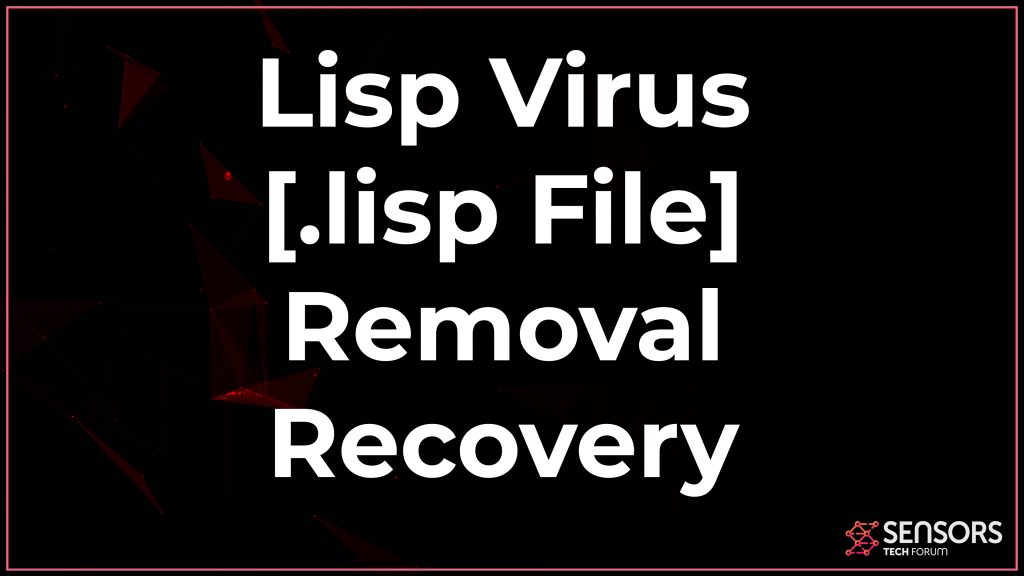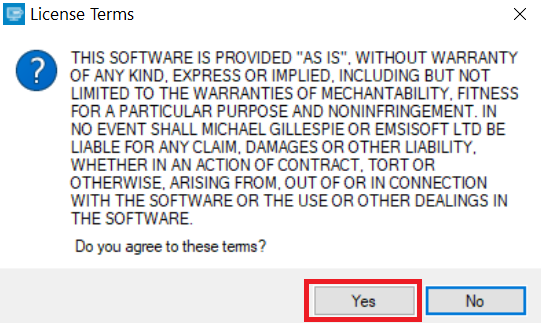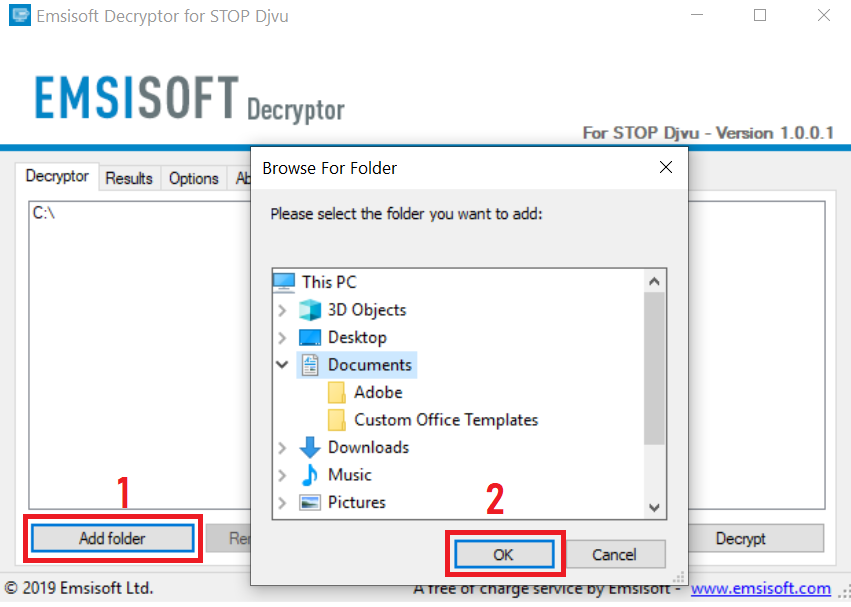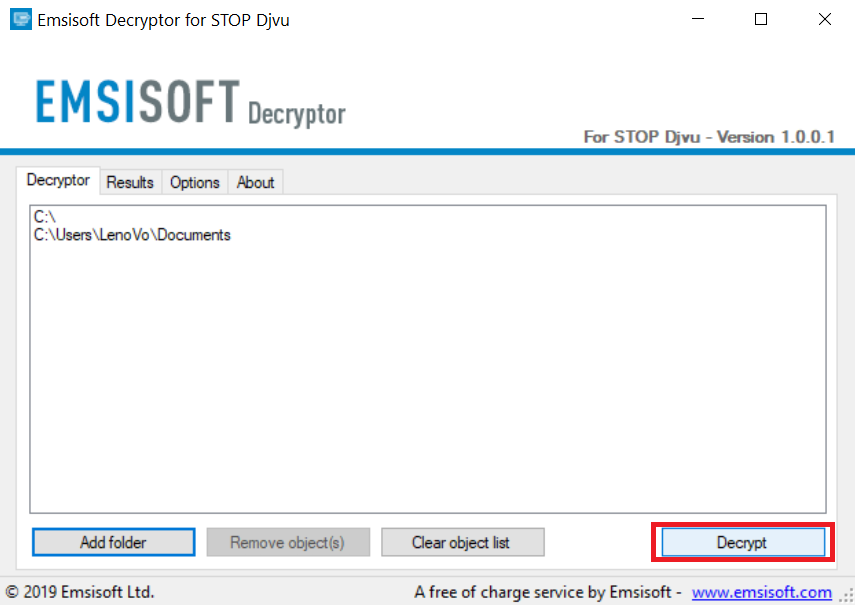What Is Lisp Virus Ransomware?
 Lisp is the name of a cryptovirus that uses the .lisp suffix which it includes after the files, encoded by it. The infection is a brand-new variation of STOP/DJVU ransomware infections and also has been reported by researchers to still be effective after a years of time since STOP/DJVU ransomware infections initially started getting into computers.
Lisp is the name of a cryptovirus that uses the .lisp suffix which it includes after the files, encoded by it. The infection is a brand-new variation of STOP/DJVU ransomware infections and also has been reported by researchers to still be effective after a years of time since STOP/DJVU ransomware infections initially started getting into computers.
Together with this, the virus drops the _readme.txt ransom note, which has been created with the main purpose to get victims to make ransom payment in the form of BitCoin. This _readme.txt note contains extortion messages that intend to scare victims off by specifying to them that their only shot at obtaining their files back is to pay the ransom money.

Lisp Virus Summary
| Name | Lisp |
| File Extension | .lisp |
| Type | Ransomware, Cryptovirus |
| Short Description | The ransomware encrypts files on your computer system and demands a ransom to be paid to allegedly recover them. |
| Symptoms | The Lisp ransomware will encrypt your files by appending the .lips extension to them. |
| Ransom Demanding Note | _readme.txt |
| Distribution Method | Spam Emails, Email Attachments |
| Detection Tool |
See If Your computer Has Been Affected by malware or other threats. Download
Malware Removal Tool
|
User Experience | Join Our Forum to Discuss Lisp virus. |
Lisp Virus – More Information
There are two primary types of spread means which are used for the infection strategy of the Lisp infection:
- Harmful files.(. js,. docx,. pdf,. exe,. bat,. cmd).
- Harmful web links.
In case this virus is executed through harmful files, then the Lisp infection could be distributed either by having its information published on websites where the malware could appear like a legitimate file, software activator, patch, installer, mobile application, or any other type of application that is created to deceive you right into downloading and running the virus.
Yet this is not the only method through which you can become infected with the Lisp ransomware virus. One more method of infection includes e-mail spam messages. These are typically sent out by the criminals and also typically appear to pose as authentic kinds of messages that intend to send you a doc, similar to a receipt, airplane ticket revoked, or others.
In case the infection is done by sending out malicious links, it can occur in different means. It could be because of a suspicious and risky ad triggers you a redirect or it could occur if you have gotten a message from Facebook message, Skype, Viber, etc. As quickly as these web links are opened, an infection script can be activated on your computer system to infect it with Lisp ransomware.
As soon as Lisp virus ransomware finds itself on your computer system, it might start to drop its infection objects.
They may exist in the sticking to Windows directory site websites:
- %Roaming%
- %Temp%
- %Windows%
- %SystemDrive%
- %Local%
- %ProgramData%
- %system32%
- %LocalLow%
Lisp infection can carry out various activities once it enters your computer. Such could be:
- Perform a scan to see if it has been ran on this PC before.
- Obtain saved login details illegaly.
- Get admin permissions and tamper with mutexes.
- Check your IP and region and languange.
Lisp infection belongs to the virus family of STOP Ransomware infections, and is comparable to all the other variants, for example, the one with .promorad extension. After encryption, the virus includes its own suffix to the data, which in this circumstance is .lisp.
After that, the infection might furthermore start to change strings in the following kinds of Windows Reigstry sub-keys on the infected computer system:
→ CurrentVersion\Run
CurrentVersion\RunOnce
\LogonUI\Background
\Windows\Personalization
\Control Panel\Desktop
CurrentVersion\Run
CurrentVersion\RunOnce
Yet in addition, the Lisp infection might make sure that each one of the file recovery alternatives from the targeted PC are eliminated. For this to occur, it might run these commands as administrator in Windows Command Prompt:
→ cmd.exe /C bcdedit /set {default} recoveryenabled No
sc stop wuauserv
sc stop BITS
sc stop ERSvc
cmd.exe /C bcdedit /set {default} bootstatuspolicy ignoreallfailures
sc stop WerSvc
sc stop VVS
sc stop wscsvc
sc stop WinDefend
C:\Windows\System32\cmd.exe” /C vssadmin.exe Delete Shadows /All /Quiet
In order to make sure the files are encrypted on your computer, the Lisp infection may check for them by their file type. The Lisp virus might scan, detect and then encrypt the following kinds of files:
- Video formats.
- Documents.
- Audio.
- Image files.
- Files that are database segments.
- Archive file types.
- Virtual drive files.
Paying the ransom to the hackers that have made the Lisp virus is strongly not recommended and researchers highly advise that you focus on deleting the virus plus concentrate on bringing back the files later.

Remove Lisp Virus and Try Restoring Files
Before deleting this ransomware, we suggest that you save the encrypted files somewhere else. This will ensure that your files are risk-free, even if they are currently unopenable.
In case you intend to get rid of the Lisp virus, we advise that you concentrate on the removal instructions underneath. They intend to assist you to remove the malware either by yourself or using an automatic approach. For maximum efficiency, we highly recommend that you focus on removing the risk immediately. This can occur if you download and install a credible anti-malware application that will take care of the removal and additionally make sure that your machine is protected from threats, like Lisp in the future.
To attempt and recover information, we recommend that you have a look at the data restore steps listed below. They are made to guarantee that they assist you to restore as much data as possible, despite the fact that that they are not a 100% guarantee to redeem your data. Yet they are a short-term choice, at the minimum until a free decryptor for this variant of STOP Ransomware is out.
- Step 1
- Step 2
- Step 3
- Step 4
- Step 5
Step 1: Scan for Lisp virus with SpyHunter Anti-Malware Tool



Ransomware Automatic Removal - Video Guide
Step 2: Uninstall Lisp virus and related malware from Windows
Here is a method in few easy steps that should be able to uninstall most programs. No matter if you are using Windows 10, 8, 7, Vista or XP, those steps will get the job done. Dragging the program or its folder to the recycle bin can be a very bad decision. If you do that, bits and pieces of the program are left behind, and that can lead to unstable work of your PC, errors with the file type associations and other unpleasant activities. The proper way to get a program off your computer is to Uninstall it. To do that:


 Follow the instructions above and you will successfully delete most unwanted and malicious programs.
Follow the instructions above and you will successfully delete most unwanted and malicious programs.
Step 3: Clean any registries, created by Lisp virus on your computer.
The usually targeted registries of Windows machines are the following:
- HKEY_LOCAL_MACHINE\Software\Microsoft\Windows\CurrentVersion\Run
- HKEY_CURRENT_USER\Software\Microsoft\Windows\CurrentVersion\Run
- HKEY_LOCAL_MACHINE\Software\Microsoft\Windows\CurrentVersion\RunOnce
- HKEY_CURRENT_USER\Software\Microsoft\Windows\CurrentVersion\RunOnce
You can access them by opening the Windows registry editor and deleting any values, created by Lisp virus there. This can happen by following the steps underneath:


 Tip: To find a virus-created value, you can right-click on it and click "Modify" to see which file it is set to run. If this is the virus file location, remove the value.
Tip: To find a virus-created value, you can right-click on it and click "Modify" to see which file it is set to run. If this is the virus file location, remove the value.
Before starting "Step 4", please boot back into Normal mode, in case you are currently in Safe Mode.
This will enable you to install and use SpyHunter 5 successfully.
Step 4: Boot Your PC In Safe Mode to isolate and remove Lisp virus





Step 5: Try to Restore Files Encrypted by Lisp virus.
Method 1: Use STOP Decrypter by Emsisoft.
Not all variants of this ransomware can be decrypted for free, but we have added the decryptor used by researchers that is often updated with the variants which become eventually decrypted. You can try and decrypt your files using the instructions below, but if they do not work, then unfortunately your variant of the ransomware virus is not decryptable.
Follow the instructions below to use the Emsisoft decrypter and decrypt your files for free. You can download the Emsisoft decryption tool linked here and then follow the steps provided below:
1 Right-click on the decrypter and click on Run as Administrator as shown below:

2. Agree with the license terms:

3. Click on "Add Folder" and then add the folders where you want files decrypted as shown underneath:

4. Click on "Decrypt" and wait for your files to be decoded.

Note: Credit for the decryptor goes to Emsisoft researchers who have made the breakthrough with this virus.
Method 2: Use data recovery software
Ransomware infections and Lisp virus aim to encrypt your files using an encryption algorithm which may be very difficult to decrypt. This is why we have suggested a data recovery method that may help you go around direct decryption and try to restore your files. Bear in mind that this method may not be 100% effective but may also help you a little or a lot in different situations.
Simply click on the link and on the website menus on the top, choose Data Recovery - Data Recovery Wizard for Windows or Mac (depending on your OS), and then download and run the tool.
Lisp virus-FAQ
What is Lisp virus Ransomware?
Lisp virus is a ransomware infection - the malicious software that enters your computer silently and blocks either access to the computer itself or encrypt your files.
Many ransomware viruses use sophisticated encryption algorithms to make your files inaccessible. The goal of ransomware infections is to demand that you pay a ransom payment to get access to your files back.
What Does Lisp virus Ransomware Do?
Ransomware in general is a malicious software that is designed to block access to your computer or files until a ransom is paid.
Ransomware viruses can also damage your system, corrupt data and delete files, resulting in the permanent loss of important files.
How Does Lisp virus Infect?
Via several ways.Lisp virus Ransomware infects computers by being sent via phishing emails, containing virus attachment. This attachment is usually masked as an important document, like an invoice, bank document or even a plane ticket and it looks very convincing to users.
Another way you may become a victim of Lisp virus is if you download a fake installer, crack or patch from a low reputation website or if you click on a virus link. Many users report getting a ransomware infection by downloading torrents.
How to Open .Lisp virus files?
You can't without a decryptor. At this point, the .Lisp virus files are encrypted. You can only open them once they are decrypted using a specific decryption key for the particular algorithm.
What to Do If a Decryptor Does Not Work?
Do not panic, and backup the files. If a decryptor did not decrypt your .Lisp virus files successfully, then do not despair, because this virus is still new.
Can I Restore ".Lisp virus" Files?
Yes, sometimes files can be restored. We have suggested several file recovery methods that could work if you want to restore .Lisp virus files.
These methods are in no way 100% guaranteed that you will be able to get your files back. But if you have a backup, your chances of success are much greater.
How To Get Rid of Lisp virus Virus?
The safest way and the most efficient one for the removal of this ransomware infection is the use a professional anti-malware program.
It will scan for and locate Lisp virus ransomware and then remove it without causing any additional harm to your important .Lisp virus files.
Can I Report Ransomware to Authorities?
In case your computer got infected with a ransomware infection, you can report it to the local Police departments. It can help authorities worldwide track and determine the perpetrators behind the virus that has infected your computer.
Below, we have prepared a list with government websites, where you can file a report in case you are a victim of a cybercrime:
Cyber-security authorities, responsible for handling ransomware attack reports in different regions all over the world:
Germany - Offizielles Portal der deutschen Polizei
United States - IC3 Internet Crime Complaint Centre
United Kingdom - Action Fraud Police
France - Ministère de l'Intérieur
Italy - Polizia Di Stato
Spain - Policía Nacional
Netherlands - Politie
Poland - Policja
Portugal - Polícia Judiciária
Greece - Cyber Crime Unit (Hellenic Police)
India - Mumbai Police - CyberCrime Investigation Cell
Australia - Australian High Tech Crime Center
Reports may be responded to in different timeframes, depending on your local authorities.
Can You Stop Ransomware from Encrypting Your Files?
Yes, you can prevent ransomware. The best way to do this is to ensure your computer system is updated with the latest security patches, use a reputable anti-malware program and firewall, backup your important files frequently, and avoid clicking on malicious links or downloading unknown files.
Can Lisp virus Ransomware Steal Your Data?
Yes, in most cases ransomware will steal your information. It is a form of malware that steals data from a user's computer, encrypts it, and then demands a ransom in order to decrypt it.
In many cases, the malware authors or attackers will threaten to delete the data or publish it online unless the ransom is paid.
Can Ransomware Infect WiFi?
Yes, ransomware can infect WiFi networks, as malicious actors can use it to gain control of the network, steal confidential data, and lock out users. If a ransomware attack is successful, it could lead to a loss of service and/or data, and in some cases, financial losses.
Should I Pay Ransomware?
No, you should not pay ransomware extortionists. Paying them only encourages criminals and does not guarantee that the files or data will be restored. The better approach is to have a secure backup of important data and be vigilant about security in the first place.
What Happens If I Don't Pay Ransom?
If you don't pay the ransom, the hackers may still have access to your computer, data, or files and may continue to threaten to expose or delete them, or even use them to commit cybercrimes. In some cases, they may even continue to demand additional ransom payments.
Can a Ransomware Attack Be Detected?
Yes, ransomware can be detected. Anti-malware software and other advanced security tools can detect ransomware and alert the user when it is present on a machine.
It is important to stay up-to-date on the latest security measures and to keep security software updated to ensure ransomware can be detected and prevented.
Do Ransomware Criminals Get Caught?
Yes, ransomware criminals do get caught. Law enforcement agencies, such as the FBI, Interpol and others have been successful in tracking down and prosecuting ransomware criminals in the US and other countries. As ransomware threats continue to increase, so does the enforcement activity.
About the Lisp virus Research
The content we publish on SensorsTechForum.com, this Lisp virus how-to removal guide included, is the outcome of extensive research, hard work and our team’s devotion to help you remove the specific malware and restore your encrypted files.
How did we conduct the research on this ransomware?
Our research is based on an independent investigation. We are in contact with independent security researchers, and as such, we receive daily updates on the latest malware and ransomware definitions.
Furthermore, the research behind the Lisp virus ransomware threat is backed with VirusTotal and the NoMoreRansom project.
To better understand the ransomware threat, please refer to the following articles which provide knowledgeable details.
As a site that has been dedicated to providing free removal instructions for ransomware and malware since 2014, SensorsTechForum’s recommendation is to only pay attention to trustworthy sources.
How to recognize trustworthy sources:
- Always check "About Us" web page.
- Profile of the content creator.
- Make sure that real people are behind the site and not fake names and profiles.
- Verify Facebook, LinkedIn and Twitter personal profiles.















I will follow with interest. All my files have the .lisp extension and are encrypted by an online key, no decryption tool works.
same here, i hope we get a decryption tool soon bro